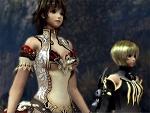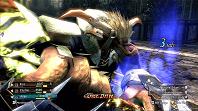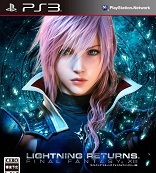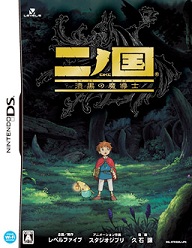Magna Carta 2
Xbox 360
Reviewed: 12/20/2009
 First things first, this was never truly clear in any of the materials on the game: the Magna Carta series has nothing to do with the historical document signed by King John of England in 1215. It may be disappointing to find out that the game just took the word “Magna Carta,” originally meaning “Great Charter, “ and took it to mean something else — a really good fighter or something like that. But that may be forgivable when many modern games have silly non-word titles like “Infinite Undiscovery,” or oxymorons like “Final Fantasy XIII.” This is definitely not for anyone looking for a series tying heavily into the history of England in the middle ages.
First things first, this was never truly clear in any of the materials on the game: the Magna Carta series has nothing to do with the historical document signed by King John of England in 1215. It may be disappointing to find out that the game just took the word “Magna Carta,” originally meaning “Great Charter, “ and took it to mean something else — a really good fighter or something like that. But that may be forgivable when many modern games have silly non-word titles like “Infinite Undiscovery,” or oxymorons like “Final Fantasy XIII.” This is definitely not for anyone looking for a series tying heavily into the history of England in the middle ages.
Magna Carta 2’s hero is the amnesiac young Juto living on Highwind Island. Whatever trauma he suffered that caused him to forget his past also caused him to be unable to use swords. Well, rather, pick up swords. And only metal swords. Not wooden swords. He uses a wooden sword at the beginning, because it does not apparently count as a sword to his traumatized mind. And at one point he is shown whittling it with a knife, too. Maybe Juto should have just learned how to use knives in combat rather than study how to use a sword with his debilitating swordphobia. Though it’s not like he has trouble wacking dudes with swords when it comes down to it. He just cannot use a metal sword. That is, until he can about an hour into the game, when his supposed mentor dies, and he joins an exiled princess fight for her homeland, and to take revenge on his mentor’s murderer. Then he can use a sword.
 |
| The graphics themselves don’t look bad, just the characters |
One of the large problems with Magna Carta 2’s story is how seriously it takes itself, and how hard it is to take it seriously. It tries to be a fantasy war story, and it is rather reminiscent of Final Fantasy XII in many ways, especially in the way it’s presented. However, the writing and the voice acting are both over the top melodramatic, and the characters are more like caricatures of common RPG archetypes than anything else. Juto, for one, is an amnesiac with a terrible power unknown to him, just like three generations worth of RPG heroes before him, and for a large part of the game, his motivation is the oldest one of all: revenge. Argo is the tough wise man, a character type which once existed to counter an older archetype: the tough dumb guy, but has since probably overtook its elder in popularity. Argo is like a Kimahri Ronso with more lines. He is like X-Men’s Beast. Crocell is a jerk with a soft spot and unyielding loyalty to Zephie. That is how he is described in the manual, and that is how he continues for forever, clashing with Juto, and later Celestine. Celestine is the youngest of the team, she is not even in her teens yet, and she has double Ds. Yes, she is of a different race from humans, although the differences are extremely minimal. She speaks in a high pitched voice and is in love with Argo, and it is just like Eiko’s crush on Zidane in Final Fantasy IX. Except imagine if Eiko had a voice actress, and she was terrible. And Eiko had double-Ds and remained a six year old. Better yet, don’t. Credit goes to Zephie, the princess in the story, who remains mostly stoic and tolerable throughout and not completely succumbing to the clichés of the role that she was given.
This cast of characters and their circumstances creates a cocktail of tired RPG conventions that almost everyone thought we were done with for nearly a decade. While there certainly is a market for a style of RPGs that makes us nostalgic for the past, it’s usually covered by Live and Wii Marketplace downloads of games that used the formula of RPG conventions before they became laughable in the sixth generation of consoles. Certainly those games have the plus of having no terrible voice actors, by skipping that part all together.
The gameplay on the back of the box is described as being akin to a turn based strategy RPG. It is nothing like a strategy RPG. The game’s fighting system is similar, as mentioned before, to Final Fantasy XII. Three party members one can switch at any time run around a map and whack on things with their swords or spells or whatever. The player controls one of the characters, and two get taken over by AIs. You hit things, until you start overheating, where you use a special attack to activate a Chain Break, and switch to another character to repeat. And repeat. And repeat.
The fighting system is almost tediously repetitive, hit A, hit A, hit A, hit A, hit X, D Pad, hit A, hit A, hit A, hit A, hit X, D Pad. And sure, there is variety in the special attacks, though the game’s kan system is very restrictive in one’s use of them. Kan is what allows a character to use a special ability; it is more or less MP. After it has been used, it recharges, but that will often times take a ridiculous amount of time unless one buys kamonds and accessories specifically designed to raise it. The problem lays in the fact that it is necessary to use a special attack in order to activate a chain break, and if one does not have enough kan to do it, their character overheats and is unable to move for a span of time, and following that is unable to attack. The system often times gets tedious.
Each character has two skill trees for the two styles of weapons that they use. Juto, for example, despite his swordphobia uses One Handed and Two Handed swords, Argo uses axes and hammers, Zephie uses rods and fans. Each weapon has a “Kamond Board,” which is sort of mixture between Final Fantasy VII’s materia slots and Final Fantasy X’s sphere grid. One purchases kamonds with various power ups (STR+2, Spirit+5, etc.) and places them on the board. Matching colors of Kamonds with the colors of Kamond slots on the board creates more slots for Kamonds. This system is fairly easy to use and is pretty well implemented, though it is a bit troublesome to completely remove a Kamond from a board without trading it for another, or selling the weapon completely.
 |
| Afraid of metal swords indeed…. |
The sound design and music in this game are passable, though hardly noticeable, but the voice acting is absolutely atrocious. If one is a fast reader, they can go through most cutscenes hearing very little of it, and that is a good thing because all of their characters ham up their lines to the extreme. Juto always sounds inconsolably sad in his semi-useless narration, and Zephie speaks in the calmest voice, even when she is supposed to be angry. Celestine’s voice is a travesty – for some reason voice actors, or voice directors, whoever is responsible for this phenomenon, seem to think that when one is voicing a young girl, one has to make their voice sound incredibly high pitched. This is not an isolated problem, and it is observable in almost every JRPG, in almost every anime: a young girl will speak in an indescribably high pitched voice, and it is always the same voice no matter who is voicing her. That is not how young girls sound and everyone in the world is aware of it. Everyone except, apparently, voice actor directors. They need to stop that.
The graphics and art direction in this game are a mixed bag. The cover art of this game is beautiful, as is all the character art. The two dimensional renderings of the characters earn are an extremely good pieces of anime style art, worth mad props. However, the style here does not translate well into three dimensions, causing everyone to be strangely proportioned when compared to real people. The straight-up anime style never truly works great in 3D, and games like Xenosaga can attest to that. What also doesn’t work is making androgynous characters. Elgar does not look like a man no matter who is acting out his voice. And neither does Crocell.
Overall, Magna Carta 2 is a game that does not seem to be aware of the shifting paradigms of RPG structures. It is deeply set in using extremely old clichés, character archetypes, and plots which we have seen time and time and time again over the last twenty years. The lack of good voice acting take the cliché storm even further from a possible nostalgic trip to a level that lies between obnoxious and criminal. Magna Carta 2 is a definite miss, with very little to show for it outside of pretty box art.
-Ivan Taran
| Score Breakdown | ||
| Overall Bad Out of 10 See our Review Criteria |
Gameplay | Below Average |
| Story | Bad | |
| Graphics | Average | |
| Sound/Music | Below Average | |
| Replay Value | Bad | |
| The Verdict: Three point five | ||








